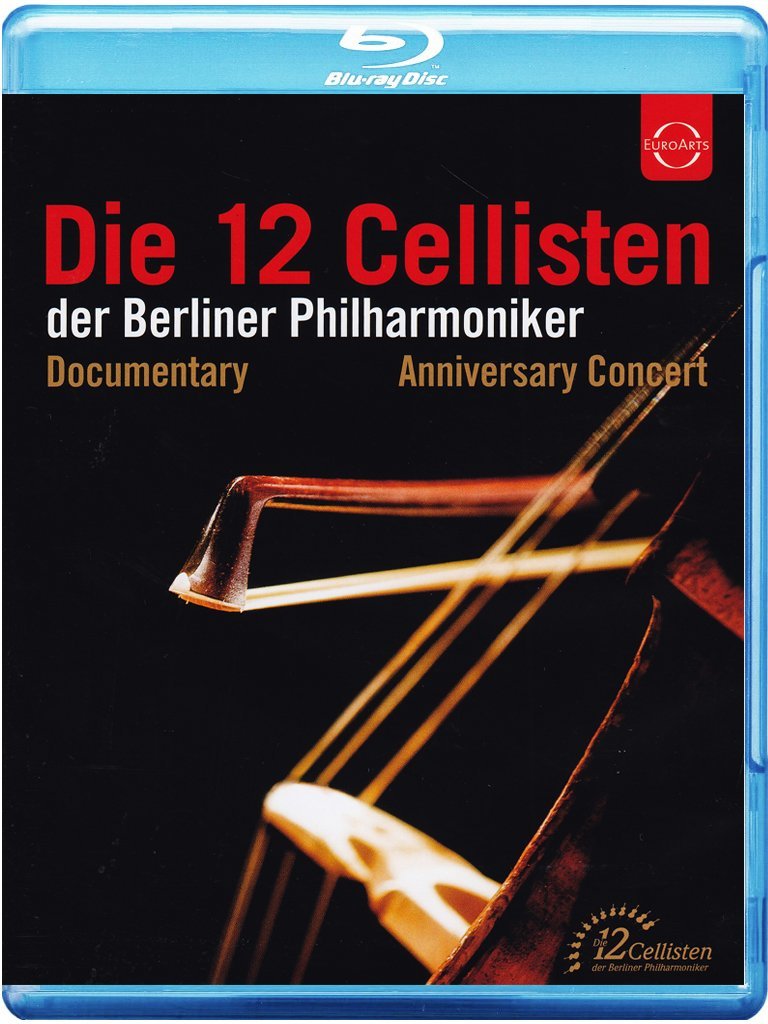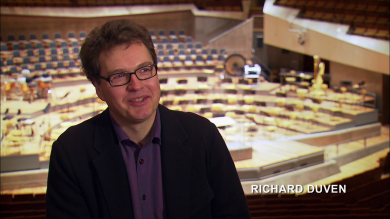

Die 12 Cellisten 40 Years Anniversary Concert. Performed 2012 at the Philharmonie Berlin by the cello section of the Berliner Philharmoniker. Cellists for the concert are (in order of seniority): Ludwig Quandt, Martin Löhr, Olaf Maninger, Richard Duven, Rachel Helleur, Christoph Igelbrink, Solène Kermarrec, Stephan Koncz, Martin Menking, David Riniker, Nikolaus Römisch, Dietmar Schwalke, and Knut Weber. If you're sharp, you'll note there are 13 names in the preceding sentence. In 2012, the cello section had been expanded to 13 members, but the repertoire of the group was still written for 12 instruments. (In February 2015, the cello section was further expanded to 14.) So some players normally get a day off. In the concert filmed for this HDVD, 12 members play the main program, and 13 play the 4 encores.
Here's the wide-ranging program:
Julius Klengel Hymnus
Jean Françaix Aubade
Astor Piazzolla Suite del Ángel
Maurice Vandair and Henri Bourtayre Fleur de Paris
Gabriel Fauré Pavane
Vincent Baptiste Scotto Sous les ponts de Paris
Michel Legrand Une femme est une femme
Herman Hupfeld As Time Goes By
Claude Debussy L'âme évaporée (Annette Dasch soprano)
Claude Debussy Les Cloches
Maurice Ravel Vocalise-Étude (Annette Dasch soprano)
Ennio Morricone The Man with the Harmonica
Juan Tizol and Duke Ellington Caravan
Astor Piazzolla Fuga y misterio
Édith Piaf La vie en rose (1st of the encores)
Wilhelm Kaiser-Lindemann Bossa for Twelve
Thelonious Monk Round Midnight (Till Brönner trumpet)
The Beatles Yesterday
For the concert: Directed for TV by Michael Beyer; photography directed by Günter Euringer; sound directed by Christian Feldgen; edited by Cetin Tutak. Produced by Grete Liffers and Claudia Krüger. Title also includes a 59 minute documentary, The 12 Cellists. For the documentary: Directed for TV by Enrique Sánchez Lansch; directed for photography by Isabelle Casez and Henning Brümmer; sound directed by Andreas Köppen; edited by Julia Oehrig; sound editing by Sven Piesker. Released 2012, disc has 5.1 dts-HD Master Audio sound output. Grade: B+
I was not enthusiastic about this title when I bought it. But if it's good enough for Mr. Sting and his wife Trudie Styler (the famous and happy Twin Spirits couple on the left of the second row from the bottom), it ought to be good enough for me. The first two times I watched this, I thought the sound of 12 cellos to be too monotonous and raspy. But then I got over that and began to enjoy the music more and more. The composers and arrangers for the 12 Cellisten keep the numbers short and varied. The purpose of this music isn't to compete with chamber music generally — the purpose is to have fun showing off the virtuosity and versatility of the cellists:
And how do you make a video of 12 cellists without boring the viewers? The next screenshot shows their standard seating arrangement:
Obviously the TV director has to vary the angles often as you see in the next two screenshots:
And here's the prettiest shot of all during a number when the lights were turned up. This group of super-elite players seems to be very democratic. On your far left is the leader, Ludwig Quandt. On your far right is Martin Löhr, who is, I think, second in command. I get the impression that the assignments for playing melody, harmony, rhythm, and even percussion parts of the repertoire are distributed evenly so that everybody gets to do everything.
When you become a member of the cello section at the BPO, you take on two careers: (1) a member of a great orchestra and (2) a member of a unique chamber music ensemble. Your career with the 12 is entirely lived out at times when the BPO is off-season. This must be a very demanding life. As far as I can tell, everyone in the section is required to do it all. I wonder: is any room left for office-politics in a group like this? Or do the members develop a deep relationship like soldiers facing a common enemy? And do all the rehearsals and performances as a section give them a unique advantage over cello sections in other orchestras?
Thank Goodness there's only one really bad shot like this:
To add variety to the video, the TV director can add close-ups like this shot of the intellectual-looking Martin Minkus:
Or this profile of the rugged-looking Olaf Maninger:
Or the patrician-looking Stephan Koncz:
You also get to see many combination shots like this one of Knut Weber and Rachel Helleur:
From left to right: Ludwig Quandt, Nikolaus Römisch, Dietmar Schwalke, and Richard Duven:
Guest star Annette Dasch has 3 numbers:
The 12 get to dip into cross-over a bit as well as modern music written just for them. Here's Till Brönner, a jazz trumpet player who has collaborated with the 12 over the years:
What wrong with this picture? Well, here all 13 players are on stage for the encores:
The disc has is a documentary, The 12 Cellists. I could not get the documentary to play from the menu. Fortunately, my Oppo BDP-93 has a "Go-To" feature that lets me access any track and chapter on the disc directly even if the menu is messed up. The documentary is disjointed and poorly edited, especially the sound which varied from clip to clip from very soft to very loud. Still, the documentary, however poorly made, would interesting for cello players and die-hard fans of Die 12 Cellisten group. And the documentary does match up the names to the faces of the players.
Here are interview pictures of the players from the documentary arranged in the order they sit for the encores to the concert:
To sum up, Die 12 Cellisten is a unique and impressive group that has stayed together and built a fan base over 40 years. The wide range of the cello makes it possible to do this (don't ask me to a concert of 12 violas or 13 horns). It takes a while to get used to this act, but with the 13 selections on subject disc, there's something everyone should like.
It's too bad this wasn't recorded with 96kHz/24-bit sound sampling; this elite group deserves the best technology. But on the other hand, there is no DVDitis problem with with this disc of the sort that troubles most of our symphony recordings. I give an "A" to 7 of the numbers and a "B" or "C" to the rest. The selections I liked the best were the relatively simple pieces that hand a lot of melody to different players. My favorite is the Fauré Pavane. I know the Pavane from our Fauré Requiem HDVD, and I recently heard it live with the Dallas Symphony Orchestra and Chorus. I was impressed how well this big-scale music scales down to a chamber group of 12 cellos. Grade: B+
Here’s a YouTube video of the anniversary concert:


























